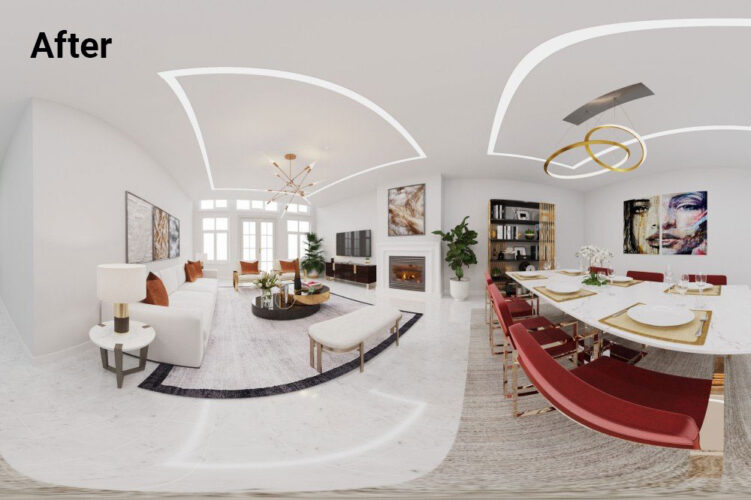The Future of Real Estate Photo Editing: AI and Emerging Technologies
In today’s digital era, visual content plays a crucial role in attracting potential buyers and tenants in the real estate industry. High-quality and visually appealing photographs have the power to capture attention and evoke emotions, making them an essential marketing tool. As technology continues to advance at an unprecedented rate, the future of real estate photo editing is being shaped by the integration of artificial intelligence (AI) and emerging technologies. In this article, we will explore the impact of AI and emerging technologies on real estate photo editing, their benefits, challenges, and the future possibilities they hold.
The Importance of Real Estate Photo Editing
Real estate photo editing is the process of enhancing property images to make them more visually appealing and enticing. It involves tasks such as adjusting brightness and contrast, correcting colors, removing unwanted objects, and adding virtual furniture or decorations. Effective photo editing can transform ordinary images into stunning visuals that showcase the property’s best features, ultimately attracting potential buyers or tenants.
Traditional Real Estate Photo Editing Techniques
Traditionally, real estate photo editing has been carried out through manual editing or by outsourcing editing services. Manual editing requires skilled professionals to manually edit each photograph using photo editing software. On the other hand, outsourcing editing services involve sending the raw images to professional editing companies who then enhance them according to the client’s requirements. While these methods have served the industry well, they can be time-consuming and costly.
The Rise of AI in Real Estate Photo Editing
With the advent of AI, real estate photo editing has been revolutionized. AI algorithms can analyze and understand the content of an image, allowing for automated editing processes. This not only saves time and effort but also ensures consistent editing quality across a large number of images. AI-based automated editing tools can perform tasks such as image enhancement, object removal, and even virtual staging.
Benefits of AI in Real Estate Photo Editing
The integration of AI in real estate photo editing brings numerous benefits. Firstly, AI-powered algorithms can analyze images and automatically enhance them by adjusting brightness, contrast, and colors. This ensures that the final images are visually appealing and consistent. Secondly, AI can efficiently remove unwanted objects from images, such as photobombers or clutter, creating a clean and professional look. Additionally, AI can also automate virtual staging, where virtual furniture and decorations are added to vacant rooms, giving potential buyers or tenants a better visualization of the space.
AI-based Automated Editing Tools
Several AI-based automated editing tools have emerged in the market, catering specifically to the real estate industry. These tools utilize machine learning algorithms to analyze and enhance images, making the editing process faster and more efficient. Some tools even offer features like automatically detecting and straightening vertical lines in architectural images or generating HDR (High Dynamic Range) images from a single exposure.
Emerging Technologies in Real Estate Photo Editing
In addition to AI, several emerging technologies are shaping the future of real estate photo editing. These technologies are pushing the boundaries of visual content creation and delivering immersive experiences to potential buyers or tenants.
Virtual Staging
Virtual staging is a technology that allows real estate professionals to digitally furnish and decorate a vacant space. By using virtual furniture and decorations, real estate agents can showcase the potential of a property without the need for physical staging. Virtual staging not only saves costs but also provides flexibility in customization and allows potential buyers or tenants to envision themselves in the space.
Virtual Reality Tours
Virtual reality (VR) tours provide an immersive experience to potential buyers or tenants by allowing them to virtually explore a property. With the help of VR headsets, users can navigate through different rooms and get a realistic sense of the property’s layout and ambiance. This technology provides a convenient way for remote buyers to experience a property without physically visiting it.
Augmented Reality Applications
Augmented reality (AR) applications enable users to overlay virtual elements onto the real world using their smartphones or tablets. In the context of real estate, AR can be used to superimpose virtual furniture, decorations, or even architectural changes onto a property in real-time. This allows potential buyers or tenants to visualize the possibilities and make informed decisions.
3D Rendering
3D rendering is the process of creating a realistic image or animation from a 3D model. In real estate, 3D rendering is used to create visually stunning images or virtual tours of properties that are still under construction or renovation. This technology provides a glimpse into the final product and helps potential buyers or tenants visualize the potential of the property.
The Impact of AI and Emerging Technologies on the Real Estate Industry
The integration of AI and emerging technologies in real estate photo editing has a significant impact on the industry as a whole.
Enhanced Visual Appeal
AI algorithms and emerging technologies enhance the visual appeal of property images, making them more attractive to potential buyers or tenants. By creating visually stunning visuals, real estate professionals can capture attention and generate more interest in the properties they represent.
Time and Cost Efficiency
Automated editing tools powered by AI save time and effort for real estate professionals. Instead of manually editing each photograph, they can rely on AI algorithms to automatically enhance images, thereby speeding up the editing process. Additionally, technologies like virtual staging eliminate the need for physical staging, saving costs associated with furniture rental and setup.
Improved Marketing and Sales
High-quality visuals created through AI and emerging technologies greatly aid in marketing and sales efforts. By showcasing visually appealing images, virtual reality tours, or augmented reality applications, real estate agents can create a memorable and immersive experience for potential buyers or tenants. This, in turn, increases the chances of conversion and accelerates the sales process.
Increased Customer Satisfaction
The use of AI and emerging technologies in real estate photo editing enhances customer satisfaction. By providing realistic visual representations of properties, potential buyers or tenants can make more informed decisions. Virtual reality tours and augmented reality applications allow them to explore properties at their own convenience, providing a higher level of engagement and satisfaction.
Challenges and Limitations of AI and Emerging Technologies
While AI and emerging technologies offer significant advantages, there are also challenges and limitations that need to be considered.
Technical Limitations
AI algorithms and emerging technologies are continually evolving, but they are not without their limitations. Some AI-based automated editing tools may struggle with complex editing tasks or may not be able to achieve the same level of precision as human editors. Similarly, emerging technologies like virtual staging or augmented reality applications may have limitations in accurately representing certain aspects of a property.
Ethical Considerations
The use of AI algorithms and emerging technologies raises ethical considerations in real estate photo editing. For example, altering images to misrepresent a property’s condition or features can be misleading and unethical. It is essential to use these technologies responsibly and ensure that the final visuals are a true representation of the property.
Skill Upgradation
The integration of AI and emerging technologies requires real estate professionals to adapt and upskill themselves. They need to familiarize themselves with the latest editing tools and technologies to effectively leverage their benefits. Upskilling and training programs can help professionals keep up with the rapid advancements in the field.
The Future of Real Estate Photo Editing
The future of real estate photo editing is exciting and holds immense possibilities.
AI-Driven Personalization
AI algorithms can analyze user preferences and behavior to provide personalized experiences. In real estate photo editing, this could mean automatically adjusting image styles and compositions based on individual preferences. By tailoring visuals to match the preferences of potential buyers or tenants, real estate professionals can create a more engaging and personalized experience.
Integration of AI with Other Technologies
The integration of AI with other emerging technologies like machine learning, natural language processing, and big data analytics can further enhance real estate photo editing. For example, AI algorithms can learn from large datasets of property images to improve editing recommendations and generate more accurate virtual staging. This integration will lead to more intelligent and efficient editing processes.
Continued Evolution and Advancements
As technology continues to evolve, real estate photo editing will also see advancements. AI algorithms will become more sophisticated and capable of handling complex editing tasks. Emerging technologies like virtual reality and augmented reality will become more accessible and realistic, providing even more immersive experiences. The future holds endless possibilities for the real estate industry, driven by AI and emerging technologies.
Conclusion
The future of real estate photo editing is being shaped by the integration of AI and emerging technologies. These technologies are revolutionizing the way property images are edited, enhancing their visual appeal, and providing immersive experiences to potential buyers or tenants. While there are challenges and limitations to consider, the benefits and possibilities offered by AI and emerging technologies are vast. With continued advancements and smart integration, real estate photo editing will continue to evolve, providing a more engaging and personalized experience for all stakeholders involved.
Frequently Asked Questions
-
How does AI improve real estate photo editing?
- AI algorithms can automatically enhance images, remove unwanted objects, and even perform virtual staging, saving time and effort for real estate professionals.
-
What are the benefits of virtual staging?
- Virtual staging allows real estate professionals to showcase the potential of a property without physical staging, saving costs and providing flexibility in customization.
-
How do virtual reality tours benefit potential buyers or tenants?
- Virtual reality tours provide an immersive experience, allowing potential buyers or tenants to virtually explore a property and get a realistic sense of its layout and ambiance.
-
What are the ethical considerations in real estate photo editing?
- It is important to ensure that edited images accurately represent the property and do not mislead potential buyers or tenants.
-
What can we expect in the future of real estate photo editing?
- The future holds AI-driven personalization, integration of AI with other technologies, and continued advancements in AI and emerging technologies for real estate photo editing.



